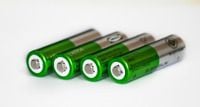)
Rechargeable batteries offer power on-the-go with two key advantages over their disposable equivalents:
1. They're far cheaper in the long run, and
2. They're better for the environment.
But because there are so many different types and brands, and because the upfront cost of purchasing a re-chargeable is higher than with buying disposables picking out rechargeable batteries is a little more difficult than battery shopping used to be.
Even storing and caring for these batteries takes a little more effort.
Rechargeable batteries can vary in their electrical capacity, even within a single size, type and brand.
The milliamp per hour rating, designated as "mAh", indicates how much energy it's capable of holding.
The higher the mAh, the more energy it's capable of delivering.
Devices where extra-long battery life is important will benefit from batteries with higher mAh ratings.
While they may cost more, you'll at least get the full benefit of your device.
What are re-chargeable batteries made of?
Originally, most re-chargeable batteries were made from nickel cadmium (NiCd).
This is now fairly uncommon for a couple of reasons.
One reason is because cadmium is a hazardous material, so NiCd batteries can pose risks if they rupture or when they collect in landfills.
Another reason NiCd batteries have become obsolete is because of the "memory effect".
When NiCd batteries are recharged before they're fully drained, they can incorrectly "remember" how much power they can hold.
After a few cycles of being recharged at 50 percent, a NiCd may behave as though it has half the capacity it actually has.
Today, most of the rechargeable AA and AAA batteries you see in the store are nickel metal hydride (NiMH).
These have no memory effect and are much lighter than NiCd batteries.
However, they also tend to drain faster, have shorter lifespans and struggle to perform in cold conditions.
One of the newest battery technology is lithium ion batteries (Li-ion).
These are the sealed batteries you typically have in your phone and computer, but they're gradually emerging as an option for everyday AAs and AAAs.
Li-ion batteries combine the best features of NiCd and NiMH batteries and will soon be the battery of choice.
Flow Batteries
With the advent of solar, the newest development in solar battery storage are Flow Batteries.
One of the core advantages that flow batteries have over lithium-ion and lead-acid batteries is that they have a 100% depth-of-discharge, which means the entire battery can be discharged in a cycle with no negative effects on the lifespan of the battery.
However, the cost of these batteries is quite high for now at least.
As an example, a 10kWh flow battery can cost around $13,000. However, as technology and usage evolves, like everything else, we can expect the cost to come down where these types of batteries may offer a viable alternative to lithium-ion or lead-acid batteries.
Simon Caddy Electrical is an electrical business specialising in general electrical, data, communications TV antennas and much more - we service the Upper North Shore area including Berowra, Hornsby, Wahroonga, Pymble, Turramurra, Killara, Lindfield, Roseville, Chatswood, Gordon and down to North Sydney.
| Tags:Electrical ServicesBatteries & Battery Techonology |
)
| Posted in:Electrical SafetyElectrical Services |
)
| Posted in:Electrical ServicesBatteries & Battery Techonology |
)
| Posted in:EnvironmentalElectrical HazardsElectrical Waste |
)
| Posted in:Electrical ServicesData & Cabling |
